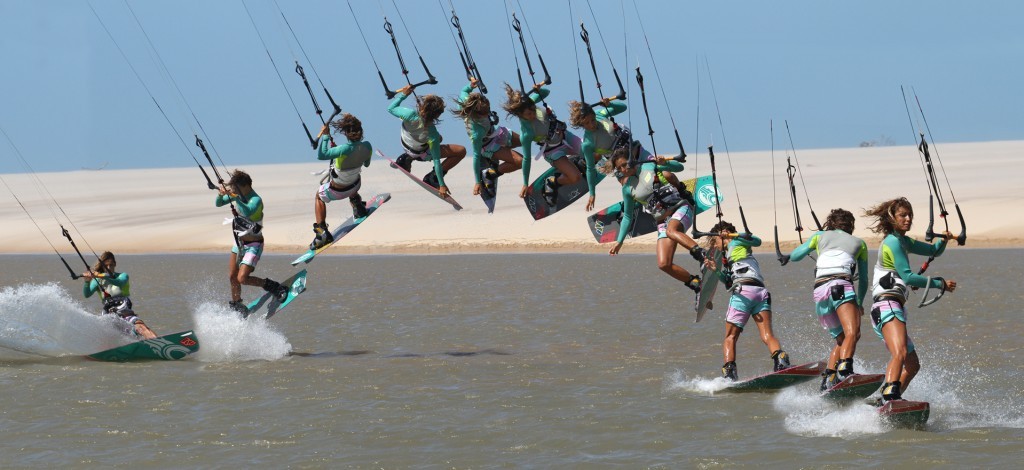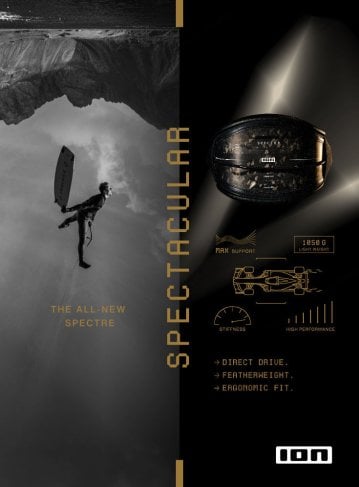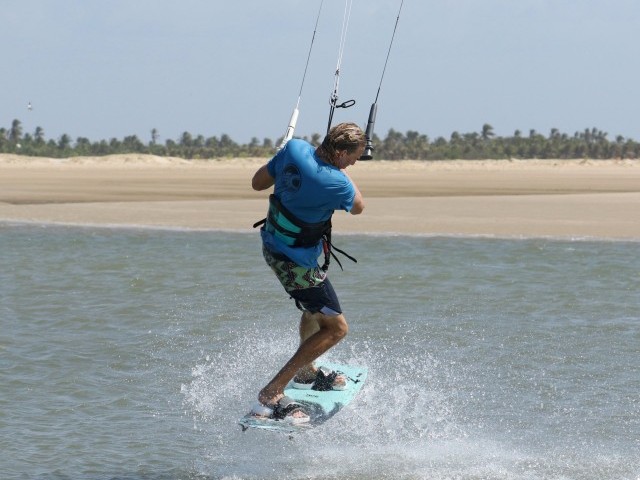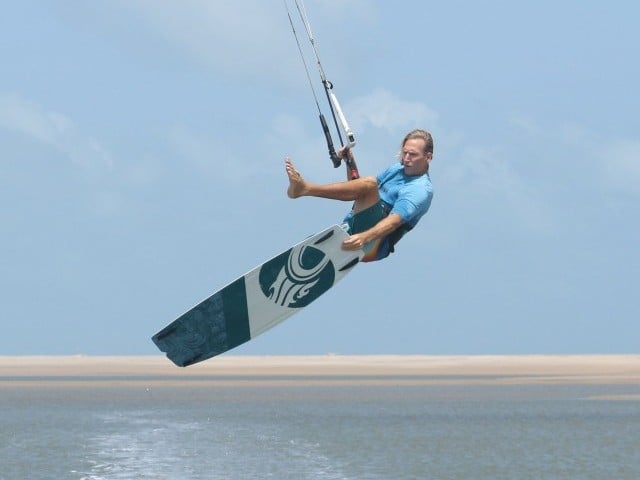
Hooked Popped Front to Blind with Grab
Technique / Intermediate
Introduction
Grabbing always adds that extra touch of style, if you’ll excuse the pun, so adding one into an already technical move should feel pretty awesome and will definitely give you some extra kudos. Here you’ll be spicing up the hooked front to blind so it’s something within many riders reach and can be performed in a wide range of conditions. As a cheeky bonus we’ll add on an ole at the end, but you’re welcome to keep riding blind.
Let’s have an in-depth look at the required building blocks to get this nailed and consistent. As a quick reminder, as with every popped trick, you’ll need to approach with your hands centred on the bar, weight back, front leg extended, bar trimmed in close enough that you can carve back up against the kite, kite at or just below 11 or 1 o’clock and off the wind. This way you’ll be ready to explode up without using the kite, but have the confidence and air to commit. The higher you have your kite the harder it will be to edge, but the more lift you’ll have, so it’s a compromise that you’ll need to balance depending on conditions and kite size. That said, for learning err on the high side so you’ll have time and won’t feel that it’s necessary to drift the kite up.
Take Off
If one word describes what your take off should be it’s ‘up’. It’s often the case that we rush into a front rotation, throwing ourselves down towards the water and not exploding up against our edge. As you carve up against the kite you should be in a strong position, bum low, front leg extended, back leg ready to stamp and shoulders back. From here you can kick hard through your back heel and explode up against your edge, fully extending before turning your head into the rotation. That said, as you kick you will move your shoulders towards the nose of the board, which will lift your front leg and give you momentum to rotate, so to initiate the rotation turn your head to look up and over your back shoulder. Do this with your kite still, but high enough and you’ll be rewarded with more than enough pop to complete the move. In the picture you can see that Karine’s back leg has fully extended, popping her up, her front knee is lifting and her shoulders and head are turning – she’s going up and around.
The Grab
Once you’ve extended and have got your rotation under way you must concentrate on the grab, as you won’t have much time. First try to bring your knees and board up towards you so that the board is within reach. We’re aiming for potentially the simplest of grabs on the heel side edge of the tail, as this is most likely the grab that you first learnt whilst jumping. As you bring the board up release your back hand and extend it down towards the tail. As you’ll be rotating fast you won’t have time to look for the grab do it by feel, even if it means that you just get a touch at first. Whilst you’re rushing through this don’t forget the kite, you need to keep the bar in on the sweet spot without pulling hard on the front hand. Here Karine is reaching down whilst lifting the board towards her, concentrating on feeling the grab and keeping the kite still.
Balance
You may find at first that you get the grab late, but even so do try and hold it until you complete your front rotation. Having both hands busy will improve your chances of claiming the landing. With only your front hand on the bar you could support yourself on your front hand, resulting in the kite moving down too low. However much like keeping two hands on the bar until you throw the blind in the non-grabbed predecessor of this trick, holding the grab until it’s time will keep you balanced and ready. You can see that Karine is holding her grab as she comes around her rotation and she will release it as she throws the blind.
Throwing the Blind
If you’ve already got some blind tricks down and in the bag you will have this part automated by now. If you’re still fairly new to blind landings hooked in there are two things to remember. Firstly, you are driving. By this we mean that you should decide when you go to blind, it should not be part of your rotation. To split your front from the blind look where you are going so that you can spot your potential landing zone and focus on it. This should hopefully aim you as if you were simply landing downwind. The second point is that you’re aiming to land over the board on your new back foot, not on an edge, so as you throw the blind you want to remain upright, you don’t want to be bending down and admiring your reflection in the water. From here you can then pull very gently on the front hand, lift your legs, release your back hand, rotate the board with your hips and turn your shoulders, finally aiming to keep your back foot high and close to your derriere. Looking at Karine you can see that as she throws the blind and turns, she is pulling her back foot up, and keeping her head and shoulders high, chin up so to speak. This will make the landing and following ole much, much easier.
The Landing
The result, as you can see in this photo, is a perfect landing. Karine is upright over the board, as you may be on a snowboard for example, but she’s touching down new back foot first which will prevent her tripping a rail or bogging the nose and sinking. Both legs are absorbing the landing and she’s pushed the bar away so that she lands with momentum and no pull from the kite. Final thought, her board is facing fairly downwind, which means that it’s very unlikely that she’ll end up on an edge, putting tension back on the lines, and she is chasing the kite which will give her time to ole.
Ole
When considering the ole it’s probably worth comparing Pic E and this one. To ole the bar you need a certain amount of slack or, if you prefer, you don’t want tension in the lines. So landing sufficiently downwind is paramount. If you land on an edge you’ll tension the lines and it’ll be impossible. In the previous photo Karine landed downwind and she also has her bar pushed away. This gives her some slack and it also prevents the kite from diving. Now, to further increase your chances of the ole you can get some weight onto your heels to make the board turn further off the wind. To achieve this you turn your head. Looking again at this photo you can see that Karine has turned her head, which rolls her shoulders around, pushing the weight back onto her heels. Having no tension now means that Karine can push the bar upwind and across in front of her face until it reaches the other side and she’s transformed her blind into toeside – magic.
Top Tips
Blind is a landing. As we mentioned earlier you’re not trying to continue your front rotation into the blind, rather momentarily focus on your landing to slow down and then throw the blind, it’s two movements.
Also the ole is an add on, don’t think of it until after you’ve landed. If you go for the ole whilst throwing the blind you’ll over rotate and plant your heelside edge, so concentrate on landing blind, and if you do this correctly you’ll have plenty of time to think and execute the ole.
Build up to this, so start with some popped fronts, then some grabbed fronts, and only then add on the blind.
Common Problems
Not enough height to get around. Either you’ve got your kite parked too low, or you’re throwing yourself down across the front of the board instead of exploding up and around into your rotation.
Not getting the grab. Bring those knees up and reach down. If it’s not automatic practice it with a sent front.
Landing hard and falling backwards. This means that you’re sneaking the kite up and as you pop it’s continuing past 12 o’clock. With little forward momentum on landing it’ll be heaving and with the kite behind 12 it’ll be difficult to throw the blind hard enough to land enough downwind, so you’ll be catching the edge. If this is happening concentrate on starting with the kite high, but keep it still.
Keystones
- Explode up and then around.
- Bring the board up and reach down with your back hand.
- Hold the grab and look for your landing.
- Release grab and throw blind.
- Lift back leg and land off the wind.
This technique article was in Issue 51 of IKSURFMAG.
Related
By Christian and Karine
Christian and Karine have been working together as a coaching team, running improver to advanced kitesurfing clinics since 2003.





























